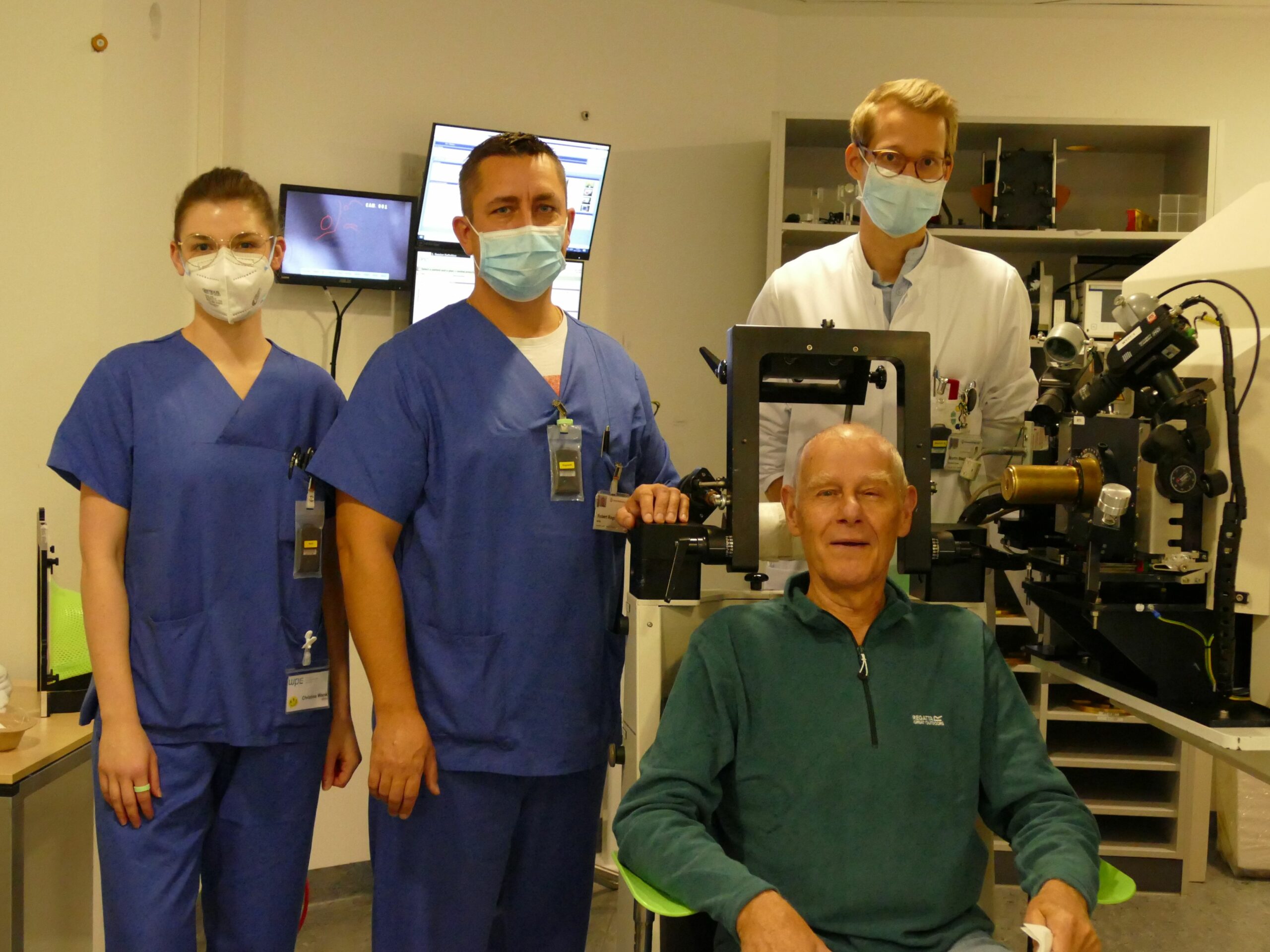
Eyeline in operation at WPE
The Clinic for Particle Therapy at the West German Proton Therapy Center Essen (WPE) of the University Medicine Essen has treated its first eye patient with a Uveal melanoma. With this, all five treatment rooms of the WPE are now in operation. The Department of Ophthalmology at the University Medicine Essen is thus the only tumor center for eye tumors worldwide to offer its patients all possible treatment modalities for combating all malignant tumors of the eye in children and adults.“The introduction of proton therapy at the University Medicine Essen in the treatment of the first patient with a malignant eye tumor is another important milestone for WPE and the Department of Ophthalmology and significantly expands the treatment spectrum,” says Prof. Dr. Jochen A. Werner, Medical Director and Chairman of the Executive Board of University Medicine Essen. The previously operating four treatment units, three of which are equipped with 360-degree rotating gantries, have now been expanded by the fifth treatment station dedicated specifically to the treatment of ophthalmic patients. This enables us to offer our national and international eye patients another outstanding oncological therapy.” This range of services in this area is unique in Europe and even worldwide.
Proton therapy has been used in the treatment of uveal melanoma since the 1970s and was introduced in Boston, USA. Since then, it has established itself as one of the standard therapies for eye tumors. Because the eye can be positioned precisely with respect to the defined proton beam, it has advantages for some ocular tumors. This is especially the case for larger tumors that are located near important structures for vision, such as the optic nerve and the center of the retina, the macula. Due to the protons’ physical properties, the beam is precisely controllable hits the tumor exactly at the intended location and destroys the tumor DNA. The tissue behind and next to the tumor is thus largely spared. “On the one hand, this aims to preserve the eye, but it also reduces the long-term risk of blindness. The chances of recovery are very good,” says Prof. Dr. Beate Timmermann, Director of the Clinic for Particle Therapy at the WPE.
Since proton therapy is very complex, it is only available for uveal melanoma at a few locations worldwide and in Germany so far at only one location outside Essen – in Berlin. University Medicine Essen is home to one of the world’s largest centers for eye tumors. Thorsten Kaatze, Commercial Director and Deputy Chairman of the Executive Board of University Medicine Essen: “It was already an important consideration when planning the WPE to set up a special eye therapy unit.” The initial focus was on commissioning the four treatment rooms that went into operation between 2013 and 2016, where the range of indications has since been steadily expanded. “In the eight years since it opened, the WPE has become one of the leading centers in the treatment of tumors of the central nervous system/brain tumors and sarcomas with proton therapy, and also offers one of the largest pediatric oncology radiotherapy services in the world,” Thorsten Kaatze continues to point out. The possibility of using proton therapy for all malignant tumors of the eye another unique offering of University Medicine Essen has been added.
With this new service, University Medicine Essen now offers a complete spectrum of therapeutic options in the treatment of a wide range of malignant tumors of the eye, both in children and adults. Prof. Nikolaos Bechrakis, Director of the Department of Ophthalmology at UME: “Until now, we always had to treat proton therapy for uveal melanoma in cooperation with a center in France or Switzerland. For both our young and our adult patients, it is a great advantage to know that, regardless of logistical problems, we can offer them customized, individualized and interdisciplinary, any sensible therapy available worldwide, highly competently in Essen, directly on site at our UME campus.”
For many months, physicians, physicists and radiographers from the two clinics worked together with the Belgian proton system builder IBA and the manufacturer of the planning system RaySearch / RayStation to fine-tune the commissioning. “It was absolute teamwork – and is absolute state of the art medicine. So we know we can offer the best therapy for patients,” summarizes Prof. Dr. Beate Timmermann proudly. She continues, “The experience of the past years, in which we have gradually put the treatment rooms into operation and expanded the range of indications, has also allowed us to take this step.”
Patients with malignant tumors of the eye come from all over Germany, Europe and beyond. Prof. Timmermann: “We see ourselves well equipped in a great team for the care of eye patients in every way. All data is collected prospectively and can be used scientifically to provide future generations with an important basis for optimizing treatment.” In addition, Prof. Bechrakis emphasizes: “As a result, it is already possible to better respond to the individually optimal therapy in any given tumor situation and to further optimize it for the future based on the analysis of the data obtained.”Hospitals, referring physicians or patients with tumors of the eye can contact the following:
Department of Ophthalmology at University Medicine Essen
Director: Prof. Dr. Dr. h.c. Nikolaos E. Bechrakis
Phone: +49 201 723-2900
Web: www.augenklinik.uk-essen.de
There, within the framework of the tumor consultation, it will be evaluated which therapy option is best suited for the individual tumor disease and whether proton therapy is an option.
If you have general questions about proton therapy at WPE, please feel free to contact our Case Management:
Phone: +49 201 723-6600
Mail: wpe@uk-essen.de
